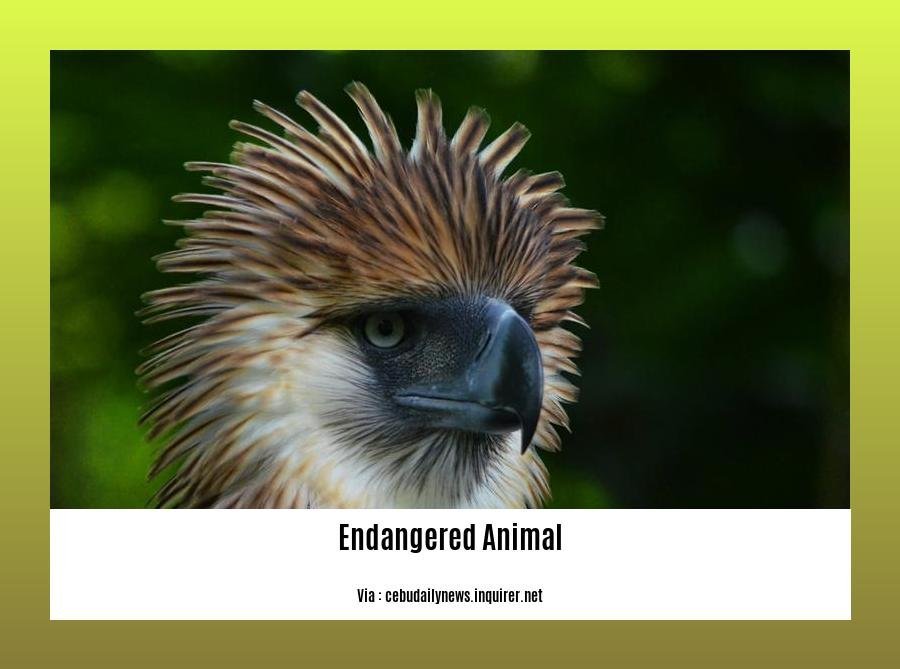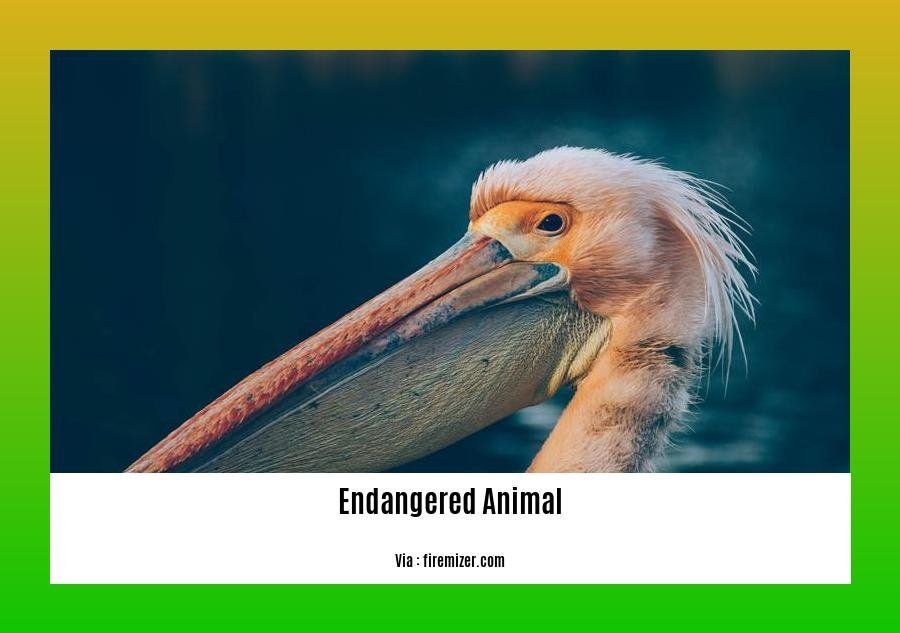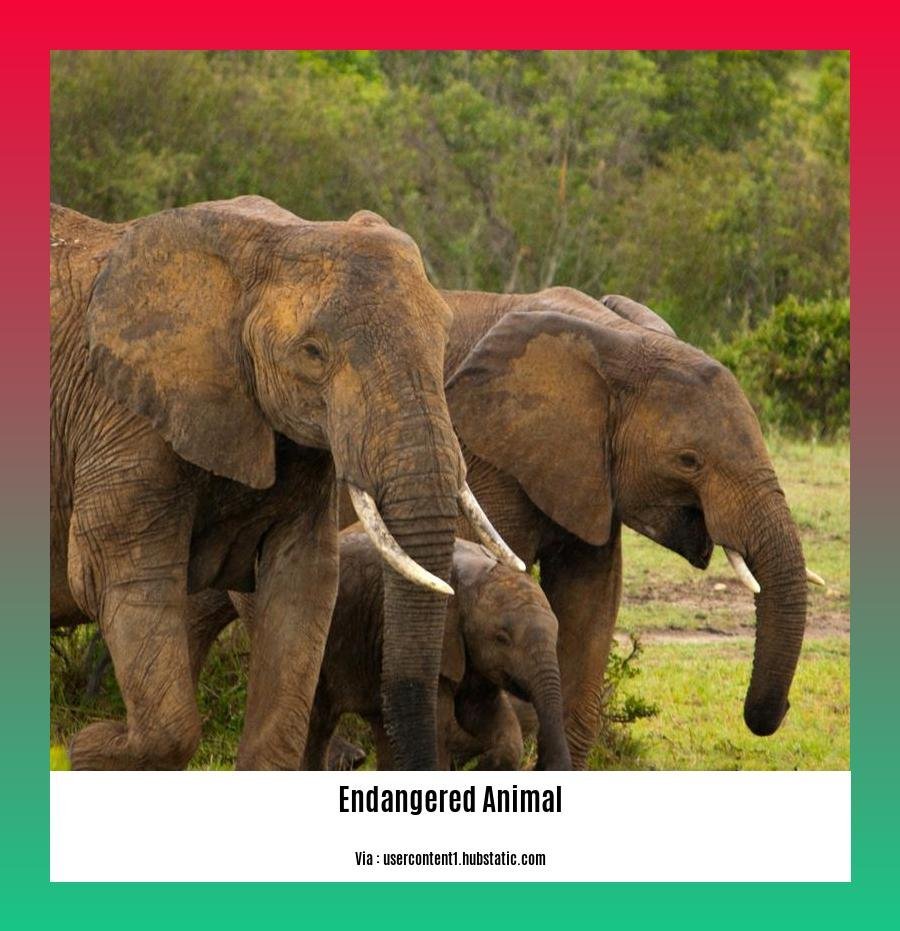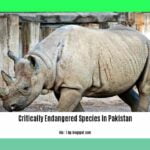Endangered Animal Species in Pakistan: Shedding Light on the Precarious Situation and Urging for Conservation Efforts
In Pakistan, the plight of endangered animal species is a growing concern that demands urgent attention. These magnificent creatures, native to the vast and diverse ecosystems of Pakistan, face a precarious situation due to various complex issues. As a seasoned wildlife conservationist, my mission is to shed light on the challenges faced by these animals and highlight the importance of conservation efforts. Through my expertise in species conservation, habitat restoration, and community engagement, I aim to inspire action and foster a greater appreciation for the unique biodiversity present within Pakistan’s ecosystems.
Key Takeaways:
- The Asian elephant, Markhor, hog deer, Asiatic wild ass, woolly flying squirrel, Kashmir muskdeer, fishing cat, and red-headed vulture are among the endangered animal species in Pakistan.
- These species face threats such as habitat loss, poaching, and illegal hunting.
- Efforts are being made by the government and conservation organizations to protect and conserve these endangered species in Pakistan.
Endangered Animal Species in Pakistan

The Precarious Situation and Urging for Conservation Efforts
Note: This article aims to shed light on the endangered animal species in Pakistan, their current situation, and the importance of conservation efforts to protect them.
Introduction
Pakistan, with its diverse ecosystems, is home to a variety of unique and endangered animal species. These magnificent creatures are facing numerous threats that jeopardize their very existence. In this article, we will explore the endangered animal species in Pakistan, their habitats, the challenges they face, and the crucial conservation efforts needed to save them.
The Asian Elephant: A Majestic Land Mammal
The Asian elephant is among the endangered land mammals in Pakistan. With its distinctive features and sheer size, it is a sight to behold. However, habitat loss and poaching have taken a toll on their population. These gentle giants desperately need our help to survive in their natural habitat.
Markhor: The National Animal of Pakistan
Considered the national animal of Pakistan, the Markhor is a majestic goat-like creature. Sadly, it is classified as “near threatened” by the International Union for Conservation of Nature (IUCN). Factors such as habitat loss and illegal hunting pose significant threats to their dwindling population. It is crucial that we take immediate action to preserve their natural habitats.
Hog Deer: A Struggle for Survival
The hog deer is another endangered land mammal in Pakistan. Their population faces constant decline due to habitat loss and illegal hunting. The destruction of their natural habitats disrupts their delicate ecosystem and pushes these graceful creatures closer to the brink of extinction. It is our responsibility to protect them and ensure their survival in the wild.
Asiatic Wild Ass: A Fight Against Extinction
The Asiatic wild ass, also known as the “ghor-khur” in Pakistan, is listed as an endangered species. Their numbers have significantly dropped due to habitat loss and poaching. With their unique adaptations, they play an essential role in maintaining the balance of the ecosystem. It is imperative that we implement effective conservation measures to save them from extinction.
Woolly Flying Squirrel: A Species on the Verge of Disappearing
The woolly flying squirrel is a rare and critically endangered species in Pakistan. Deforestation and habitat fragmentation are the main causes behind their imminent disappearance. These fascinating creatures, known for their gliding abilities, are running out of suitable habitats. Urgent efforts are needed to protect their forest homes and safeguard their existence.
Kashmir Muskdeer: A Fragile Treasure of Pakistan’s Wildlife
The Kashmir muskdeer holds a significant place in Pakistan’s wildlife. However, due to habitat loss and illegal hunting, this endangered species is on the brink of extinction. Their slender build and unique features make them an iconic species worth preserving. Let us come together to ensure a future where the Kashmir muskdeer thrives in a safe and protected environment.
Fishing Cat: Battling for Survival
The fishing cat, with its aquatic adaptations, is another endangered animal in Pakistan. Unfortunately, their population has been declining rapidly due to habitat loss and poaching. These skilled hunters play a vital role in maintaining the delicate balance of their aquatic habitats. By conserving their watery homes, we can secure the future of the fishing cat species.
Red-Headed Vulture: A Bird in Peril
The red-headed vulture holds the unfortunate distinction of being the bird most at risk of extinction in Pakistan. Their numbers have drastically declined due to factors such as habitat loss, poisoning, and lack of food availability. These majestic birds serve as important scavengers, keeping the ecosystem clean and healthy. We must act swiftly to protect their habitats and prevent their extinction.
Conclusion
The endangered animal species in Pakistan face numerous threats that endanger their survival. Habitat loss, poaching, and illegal hunting are pushing them towards extinction. However, there is hope. Efforts are being made by the government and conservation organizations to protect and conserve these species. By raising awareness, supporting conservation initiatives, and implementing effective strategies, we can safeguard the future of these magnificent creatures. Together, let us strive for a Pakistan where these endangered animal species thrive, ensuring a rich and biodiverse ecosystem for generations to come.
References:
- USA Today: Endangered Animals in Pakistan
- MangoBaaz: These 15 Endangered Animals In Pakistan Are At Risk of Extinction
Do turtles and tortoises get along? Find out more about the compatibility of these two reptiles in our article here.
Curious about dogs eating slugs and snails? Discover the fascinating behavior of these canines in our informative guide here.
Explore the endangered and extinct species in Pakistan and learn about their conservation status here.
Conservation Efforts and Initiatives in Pakistan
Key Takeaways:
- Pakistan is home to a diverse range of wildlife species, many of which are endangered.
- Over-exploitation and loss of natural habitat are the main reasons for the decline in animal species.
- Efforts such as bans on hunting and community-based conservation projects have helped protect endangered species.
- Organizations like WWF and the Protected Areas Initiative in Pakistan are working towards wildlife conservation.
- Pakistan plays a significant role in conserving globally endangered species like the snow leopard.
As a wildlife conservationist passionate about preserving endangered animal species in Pakistan, it is crucial to shed light on the precarious situation these magnificent creatures face and urge for conservation efforts. Pakistan boasts a rich biodiversity, but unfortunately, many species are at risk of extinction due to over-exploitation and loss of their natural habitats.
The Current Situation of Endangered Animal Species in Pakistan
Several endangered species in Pakistan are crying out for help. The ibex, markhor, snow leopard, Indus dolphin, and Pakistani sand cat are just a few examples. [Conservation efforts and initiatives in Pakistan] are necessary to protect and preserve the unique and diverse wildlife found within the country’s ecosystems.
Addressing Threats to Wildlife
Deforestation, overgrazing, soil erosion, salinity, and water logging pose major threats to Pakistan’s wildlife. These issues result in the loss of natural habitats and the decline in animal and plant species. Among the most effective steps taken in recent years is the banning of hunting for ibex and markhor, which has significantly protected their populations. Furthermore, community-based conservation projects have played a crucial role in preserving endangered species in Pakistan.
Role of Organizations and Initiatives
Organizations like the World Wide Fund for Nature (WWF) have been at the forefront of protecting and conserving wildlife in Pakistan. Through their diligent efforts, they promote species conservation, habitat restoration, and community engagement. Additionally, the Protected Areas Initiative in Pakistan aims to identify and preserve important habitats for wildlife, ensuring the future survival of endangered species.
The Critical Status of the Snow Leopard
Of particular concern is the critically endangered snow leopard population in Pakistan. While this species faces serious threats, Pakistan plays a significant role in its conservation on a global scale. Conservation efforts are being made to safeguard this magnificent animal and its natural habitat.
In conclusion, conservation efforts and initiatives in Pakistan hold the key to protecting and preserving the country’s unique and diverse wildlife. By raising awareness and taking necessary actions, we can ensure the survival of endangered animal species and foster a greater appreciation for Pakistan’s rich biodiversity.
Sources:
1. Conservation of endangered species in Pakistan – Pakistan Press Foundation
2. Wildlife Conservation and Rural Livelihoods in Pakistan – The Journal of Animal and Plant Sciences
Role of Habitat Restoration in Protecting Endangered Animal Species

Key Takeaways:
- Habitat protection is essential for the conservation and recovery of endangered animal species.
- Habitat restoration plays a significant role in addressing the challenges faced by these species.
- The complexity of habitat conservation and restoration is influenced by various factors, including social, economic, and ecological aspects.
- Restoring habitats can improve biodiversity in degraded ecosystems and prevent species extinctions.
- Effective habitat management, restoration, and preservation are crucial for the maintenance of threatened species within protected areas.
Habitat restoration is a crucial component of endangered species programs as it directly addresses the threat of habitat loss, which is one of the primary factors contributing to species decline. By restoring habitats, we can provide suitable and sustainable environments for these endangered animal species to thrive.
The restoration of habitats involves various actions such as identifying degraded areas, implementing restoration plans, and actively managing and preserving these habitats. This process aims to reverse the damage caused by human activities and create conditions that support the recovery and survival of endangered species.
Habitat Restoration Strategies
To effectively protect endangered animal species, habitat restoration strategies must be implemented. These strategies involve the following key steps:
1. Assessing Habitat Degradation: Understanding the extent and causes of habitat degradation is crucial for successful restoration efforts. By conducting comprehensive assessments, we can identify the most critical areas in need of restoration and prioritize our actions accordingly.
2. Restoring Habitat Connectivity: Habitat fragmentation is a significant threat to endangered animal species. By restoring habitat connectivity, we can create corridors that allow species to move freely between different areas, promoting gene flow and reducing the risks associated with genetic isolation.
3. Removing Invasive Species: Invasive species pose a significant threat to native biodiversity. Removing these invasive species from degraded habitats is crucial for the restoration of native ecosystems and the protection of endangered animal species.
4. Implementing Habitat Protection Measures: Alongside habitat restoration, it is essential to implement measures that protect habitats from further degradation. This includes enforcing regulations and creating protected areas where human activities are limited to ensure the long-term viability of endangered species’ habitats.
Benefits of Habitat Restoration
Habitat restoration initiatives can have a range of benefits for endangered animal species and their ecosystems. These include:
1. Enhancing Biodiversity: Restoring habitats improves biodiversity by providing suitable conditions for a variety of species. As habitats recover, they can support a greater number of plants, animals, and microorganisms, contributing to overall ecosystem health.
2. Mitigating Threats: Habitat restoration can help mitigate the threats faced by endangered animal species, such as habitat loss and fragmentation. By creating healthier and more connected habitats, we can provide a safer environment for these species to thrive and increase their chances of recovery.
3. Conserving Ecosystem Services: Restored habitats contribute to the provision of essential ecosystem services, such as water purification, carbon sequestration, and soil stabilization. These services not only benefit the endangered species themselves but also support human well-being and sustainable development.
4. Engaging Local Communities: Habitat restoration projects often involve collaboration with local communities. By engaging communities in the restoration process, we can raise awareness, educate people about the importance of protecting endangered species, and build a sense of stewardship for these habitats.
In conclusion, habitat restoration plays a crucial role in protecting endangered animal species in Pakistan. By focusing on restoring and preserving their habitats, we can address the complex challenges these species face. Through a combination of strategic actions, including habitat assessment, connectivity restoration, invasive species removal, and habitat protection measures, we can contribute to the recovery and conservation of these magnificent creatures. By prioritizing habitat restoration efforts and engaging local communities, we can foster a greater appreciation for the unique wildlife present within Pakistan’s ecosystems and ensure a brighter future for endangered animal species.
Sources:
- National Center for Biotechnology Information: The Role of Habitat Conservation and Recovery Planning
- Britannica: Conservation – Habitat Management, Restoration, Preservation
The Importance of Community Engagement in Biodiversity Conservation
Biodiversity conservation is essential for the protection and sustainability of our environment. To effectively address this issue, it is crucial to engage local communities in wildlife conservation efforts. By involving communities in decision-making processes and empowering them to participate actively, we can achieve better outcomes and protect endangered animal species more effectively.
Local Communities as Allies in the Fight to Save Endangered Animals
According to a report by the United Nations Environment Programme (UNEP), local communities should be treated as allies in the fight to save endangered animals. The proximity of communities to wildlife often leads to human-wildlife conflict and threats such as poaching. By involving these communities in conservation efforts, species can be better protected. Source: Global Push to Save Endangered Species, Local Communities are Key
Engaging Communities to Support Wildlife Conservation Activities
Local communities play a vital role in wildlife conservation. However, it can be challenging to engage and mobilize them effectively. Efforts must be made to involve communities through education, awareness campaigns, and training programs to enhance their understanding of the importance of conservation. Source: Engaging Communities in Wildlife Conservation – World Bank Group
Approaches to Community Engagement
To ensure successful community engagement in biodiversity conservation, various approaches can be adopted, such as community-based conservation. This approach involves integrating local communities into decision-making processes and establishing partnerships to achieve biodiversity conservation goals. Source: Community Engagement in Biodiversity Conservation – IGCP
Greater community participation, representation in decision-making processes, compliance, and strong local leadership contribute to improved ecological and biodiversity outcomes. This highlights the significance of involving local communities in conservation efforts. Source: Why communities must be at the heart of conserving wildlife, plants – The Conversation
Examples and Case Studies
The World Bank Group highlights the success of engaging communities in various activities to conserve wildlife. These activities include anti-poaching efforts, reducing wood cutting, preventing livestock encroachment, and providing training and equipment to local communities. Source: A Community of Wildlife Conservationists: Staying Engaged in Wildlife Conservation – World Bank Group
Studies on human-wildlife conflict (HWC) emphasize the importance of actively engaging local communities in wildlife conservation. These studies highlight the reasons and methods for involving communities in conservation efforts to address HWC effectively. Source: Lessons learned from community engagement and participation in wildlife conservation – ScienceDirect
Key Takeaways:
- Local communities play a crucial role in wildlife conservation efforts.
- Engaging communities through education, awareness campaigns, and training programs enhances their understanding of conservation.
- Integration of communities in decision-making processes and establishing partnerships are effective approaches.
- Community involvement leads to improved ecological and biodiversity outcomes.
- Successful case studies demonstrate the positive impact of community engagement in wildlife conservation efforts.
FAQ
Q1: How many endangered animal species are there in Pakistan?
A1: Pakistan is home to several endangered animal species, including the Asian elephant, Markhor, hog deer, Asiatic wild ass, woolly flying squirrel, Kashmir muskdeer, fishing cat, and red-headed vulture.
Q2: What are the main threats faced by endangered animal species in Pakistan?
A2: Endangered animal species in Pakistan face threats such as habitat loss, poaching, illegal hunting, and the effects of climate change.
Q3: What conservation efforts are being made to protect endangered animal species in Pakistan?
A3: The government of Pakistan and various conservation organizations are undertaking initiatives to protect and conserve endangered animal species. These efforts include habitat restoration, community engagement, anti-poaching measures, and raising awareness about the importance of conservation.
Q4: How can I contribute to the conservation of endangered animal species in Pakistan?
A4: There are several ways to contribute to the conservation of endangered animal species in Pakistan. You can support local conservation organizations through donations, volunteer for field research or community engagement programs, spread awareness about the issue through social media or educational initiatives, and practice responsible tourism when visiting areas with endangered species.
Q5: Where can I find more information about endangered animal species in Pakistan?
A5: You can find more information about endangered animal species in Pakistan from reliable sources such as wildlife conservation organizations, research publications, and reputable websites like USA Today and MangoBaaz, which provide comprehensive lists and details about endangered animals in Pakistan.
- Crypto Quotes’ Red Flags: Avoid Costly Mistakes - June 30, 2025
- Unlock Inspirational Crypto Quotes: Future Predictions - June 30, 2025
- Famous Bitcoin Quotes: A Deep Dive into Crypto’s History - June 30, 2025




![Saving the [Example of Endangered Species in Pakistan]: A Call to Action for Conservation Efforts example-of-endangered-species-in-pakistan_2](https://www.lolaapp.com/wp-content/uploads/2023/12/example-of-endangered-species-in-pakistan_2-150x150.jpg)











